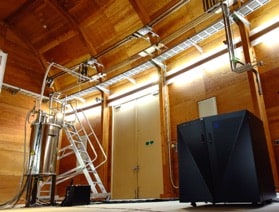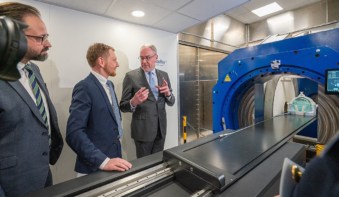
Researchers in Japan have built the first nuclear magnetic resonance (NMR) magnet that incorporates high-temperature superconductors with truly superconducting joints between them. This breakthrough all-superconducting configuration enables the device to operate at relatively high magnetic fields in so-called persistent mode, making it suitable for applications such as maglev trains and magnetic resonance imaging (MRI). The new device might also serve as a stepping-stone towards persistent-mode magnets that work at even higher magnetic fields, without the need for liquid helium coolant.
Researchers made the first superconducting NMR magnets in the 1970s using coils of wire made from niobium-titanate (NbTi) and niobium-tin (Nb3Sn), both of which are low-temperature superconductors (LTS). Magnets of this type operate in persistent mode, meaning they provide a continuous current without being fed by an external DC power supply. A further useful property is that the magnetic fields they produce decay slowly, at just 0.01 ppm/h (10-8/h), thanks to superconducting joints between the NbTi and Nb3Sn conductors.
These first-generation superconducting NMR magnets could produce magnetic fields of more than 11.7 tesla. By the 1990s, this had increased to 18.8 T thanks to superfluid helium cooling and improvements to the materials. Further increases in the maximum magnetic field levelled off at around 23.5 T, however, because the engineering critical current density Je for LTS-based magnets dramatically decreases above this value.
Switching to high-temperature superconductors
In 2014, researchers overcame the 23.5 T upper limit for high-resolution NMR magnets by combining LTS outer coils with inner coils made from high-temperature superconductors (HTSs), which retain a high Je even at higher magnetic fields. The only snag was that this magnet had to operate in driven mode (that is, continuously fed by a DC power supply) because the absence of a good, practical superconducting joint between the conductors precluded persistent-mode operation.
A team led by Yoshinori Yanagisawa of the RIKEN Center for Biosystems Dynamics Research in Yokohama has now solved this problem by constructing a magnet with superconducting joints between wires made from REBCO, which is a HTS with the chemical formula ReBa2 Cu3 O7−x (the abbreviation Re denotes a rare earth metal such as yttrium). The new magnet is the first persistent-mode 9.39 T LTS/REBCO NMR magnet with a completely superconductive circuit, and it can operate in persistent mode continuously for two years. During this time, it loses only around 1 ppm of its magnetic field. The researchers also measured a magnetic field drift rate of just 0.03 × 10-3 ppm/h over the second year, which they say is more than three orders of magnitude smaller than is required for an NMR magnet.

Superconductivity – pairing up with nanotechnology
The research, which is described in Supercond. Sci. Technol., is being done as part of a Japanese Science and Technology Agency project to develop technology for HTSs and applications involving NMR magnets and superconducting DC cables for railway systems. One of the project’s main goals is to make a high-resolution 30.5 T (1.3 GHz) LTS/HTS NMR magnet operating in persistent mode using superconducting joints between HTSs such as REBCO and low-resistance non-superconducting joints between a HTS and a LTS such as NbTi. One possible application for such a magnet would be to measure trace amounts of proteins such as amyloid β, which are known to be involved in Alzheimer’s disease, in the human brain.
For now, Yanagisawa and colleagues say that their next step will be to develop a liquid helium-free version of their NMR magnet. “Such a device could be used for magnetic resonance imaging and for maglev trains,” Yanagisawa tells Physics World.



